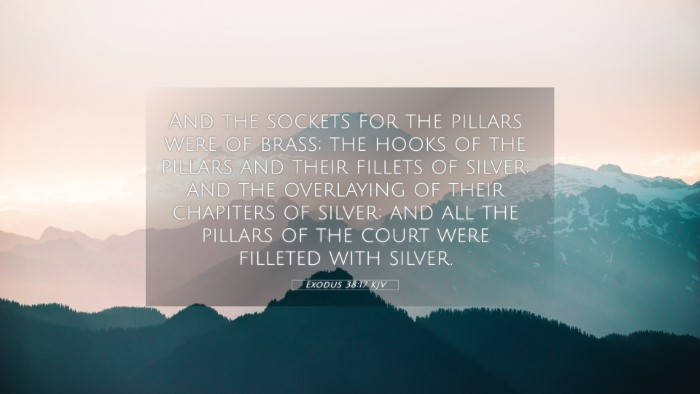Understanding Exodus 38:17
Exodus 38:17 states:
"And the sockets for the pillars were of brass; and the hooks of the pillars and their fillets were of silver; and the overlaying of their chapiters was of gold; and all the pillars of the court were filleted with silver." (Exodus 38:17 KJV)
This verse provides specific details about the materials used in the construction of the tabernacle's court, emphasizing the craftsmanship and the symbolism behind these materials.
Significance of Materials
- Brass: Represents judgment and strength. It was commonly used for items requiring durability, such as sockets, signifying the foundational strength of God's sanctuary.
- Silver: Denotes redemption. Its use in the hooks indicates the connection between the material provision and the themes of salvation and atonement.
- Gold: Symbolizes divinity and purity, enhancing the spiritual significance of the tabernacle's design. The overlaying of gold on the chapiters highlights God's glorious presence among His people.
Commentary Insights
Matthew Henry's Commentary
Henry elaborates on the significance of the tabernacle's construction, suggesting that the careful attention to detail reflects God's intention for both beauty and functionality. The use of valuable materials symbolizes the holiness of God and the wealth of His grace bestowed upon His people.
Albert Barnes' Notes
Barnes emphasizes the spiritual implications of the materials utilized. He notes that each material served not just a physical purpose but also a ritualistic significance, reminding the Israelites of God's covenantal relationship with them.
Adam Clarke's Commentary
Clarke points out that these descriptions serve to inspire reverence among worshippers. He reflects on how the overall beauty of the tabernacle would lead the Israelites to understand the greatness of God and their relationship with Him through worship.
Bible Verse Cross-References
To fully grasp the meaning of Exodus 38:17, it is essential to consider cross-references that illuminate related themes:
- Exodus 25:3-7: Lists the materials for the tabernacle's construction, emphasizing their significance.
- Exodus 26:19-30: Describes the construction of the tabernacle and its coverings, providing context for the materials mentioned.
- 1 Kings 6:20-22: Details the construction of Solomon's Temple, which reflects the tabernacle's design and materials.
- Hebrews 9:1-5: Discusses the earthly tabernacle and its components in a New Testament context, underscoring its temporary nature.
- Isaiah 54:11-12: Uses imagery of precious materials to convey security and beauty in God's plans.
- 1 Peter 2:5: Compares believers to living stones being built into a spiritual house, reflecting the significance of the tabernacle's design.
- Romans 3:23-24: Emphasizes the themes of redemption and grace, tying back to the silver hooks as a symbol of redemption.
Connections Between Bible Verses
Exodus 38:17 connects to various themes across the scriptures:
- Divine Presence: Linking Exodus 40:34-35 where the glory of God fills the tabernacle.
- Redemption and Sacrifice: Connects to Galatians 3:13 where believers are redeemed from the curse.
- Holiness: Ties to Leviticus 11:44 where God calls His people to be holy as He is holy.
Thematic Bible Verse Connections
This exploration of Exodus 38:17 shows how cross-referencing Biblical texts enhances understanding:
- Understanding God's Nature: Analyzing the materials provides insight into God's majesty and holiness.
- Symbolism in Worship: The various elements symbolize different aspects of the believer's relationship with God.
- Biblical Themes: Offers a rich tapestry of connections to the overarching narrative of redemption found throughout scripture.
Cross-Referencing Bible Study Methods
When studying the Bible, utilizing cross-references can deepen understanding:
- Bible Concordance: Use a concordance to find related passages and themes, enriching your study.
- Cross-Reference Tools: Employ tools and guides designed to highlight connections between verses.
- Comparative Studies: Examine similar themes in Old and New Testament contexts.
Conclusion
Exodus 38:17, with its intricate details and symbolic meanings, invites believers to delve into the richness of God's word. By engaging in comparative Bible verse analysis and cross-referencing, one can discover profound insights into the nature of God, His calling for His people, and the beauty of worship.
Utilizing these methods enables a deeper understanding of how various Bible verses relate to one another, providing essential tools for effective Bible study and interpretation.


